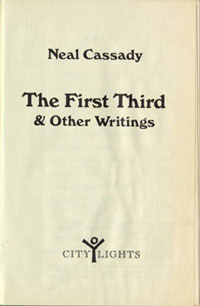- New York City Beats
- Howl and Other Poems
- Junkie: Confessions of an Unredeemed Drug Addict
- Naked Lunch
- On the Road
- The First Third and Other Writings
- Go
- Bomb
- "Let Us Inspect the Lyre"
- "Let Us Inspect the Lyre"
- Huncke's Journal
- "The Entrance of The Grand Gladiola"
- This Kind of Bird Flies Backward
- Preface to a Twenty Volume Suicide Note

Although Neal Cassady's literary output was small, he was one of the major figures of the Beat period. He became the bridge between the Beats of the fifties and the fledgling psychedelic movement of the sixties, when he joined Ken Kesey and his band of Merry Pranksters in late 1962. Cassady was raised in a condemned flophouse in Denver, Colorado, and by his early twenties he had stolen more than five hundred automobiles, had been arrested ten times, and had spent fifteen months in juvenile detention. In detention he discovered the prison library and upon his release he continued his self-education at the Denver Public Library. When he headed east in 1946 he had acquired the requisite knowledge to talk literature with the likes of Jack Kerouac, William Burroughs, and Allen Ginsberg. Ginsberg fell in love with him, Kerouac found him to be the quintessential modern American, and Burroughs was the first to make use of his soon-to-be-legendary driving skills, when he hired Cassady to drive his marijuana crop from Texas to New York in 1947. Cassady's cross-country driving trips with Jack Kerouac became the experiences from which On the Road was written, Cassady was Dean Moriarty to Keroauc's Sal Paradise. Although he was the larger-than-life model for so much of what was written during the Beat period, Cassady at times tried to maintain a middle-class existence, he lived with his wife and three children in suburban California whenever he was not on the road with his soon-to-be famous friends. Published in 1971, three years after his death in Mexico, The First Third and Other Writings is a compilation of excerpts from letters, fragments of writings, and short pieces from the memoir that Kerouac and Ginsberg encouraged him to write.

